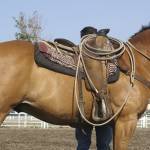Is Your Horse Ready for Trail Riding?

Trail riding is good exercise, great fun, and a wonderful way to spend time with your horse and your riding friends. Most trail riding days are positive experiences…but, unfortunately, we’ve all heard stories of trail rides that didn’t go so well. Maybe one of the horses spooked and dumped its rider, causing injuries. Or a horse went lame on the ride, or ran completely out of energy after a few miles, or got dehydrated, or started having odd hiccup-like diaphragm spasms known as “thumps,” a condition related to fatigue and electrolyte imbalance. Those days are no fun at best, and can turn into life-threatening emergencies at worst. Riders can avoid many problems by selecting the right horse, choosing the right trails, and making sure pre-trip conditioning has been carried out.
The right horse for trail riding should be at least four or five years old, completely sound, and of the right size and conformation to easily carry the weight of rider and tack. He should also have the temperament and training to suit the rider’s skill level. Riding a very young horse is not recommended because long hours of carrying a rider can be hard on muscles, bones, and joints that are not yet mature. For a horse that is questionably sound or recovering from an injury, even a brief trail ride might be enough to bring on serious lameness or a setback in recovery.
Horses younger than five years are able to support their own weight, but their skeletons are still in the process of maturing and adding bone thickness and strength that will allow them to carry the weight of a rider without sustaining injury. Shorter rides and light work are all right, but an all-day trail ride with a heavy rider can cause pain, lameness, and joint injury to a young horse.
Many owners feed grain out of habit even if their horses have plenty of forage (grass or hay) and are at acceptable body weights. Horses that are “easy keepers” can become overweight or obese if they are fed grain, and this extra weight makes it harder for them to exercise and keep up with trail mounts that are in fitter condition. For horses that gain weight easily on grain, owners should consider a vitamin-mineral supplement or a pelleted ration balancer rather than a calorie-laden commercial grain product.
Assuming your horse is at an acceptable body weight, he needs to be in good athletic condition to carry you for the miles and hours involved in a long day of riding. If you’re saddling up for a long ride on an out-of-condition horse that has done nothing but stand around the field or stall, you will almost certainly make your horse muscle-sore and possibly risk more serious injuries. Conditioning of an unfit horse must be done over a period of weeks, beginning with short periods of slow work and increasing work effort and time gradually. Remember that the horse’s respiratory and cardiovascular systems must be strengthened as well as his muscles, bones, and tendons. Once the horse is fit, it will require regular work to stay in condition. “Weekend warriors” who ride hard for hours on only one or two days each week may not ride regularly enough to keep their horses in top condition and are therefore risking tendon or muscle damage as the horse works.
If horses are young or in less than top condition, choose trails that are not too long or strenuous, and watch for signs of fatigue and dehydration. Water the horses before, during, and after the ride, and consider using an electrolyte in hot, humid weather. Save the more difficult treks for a cooler day, and make a plan to increase the horse’s fitness before tackling those really tough trails.








